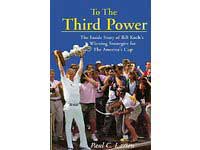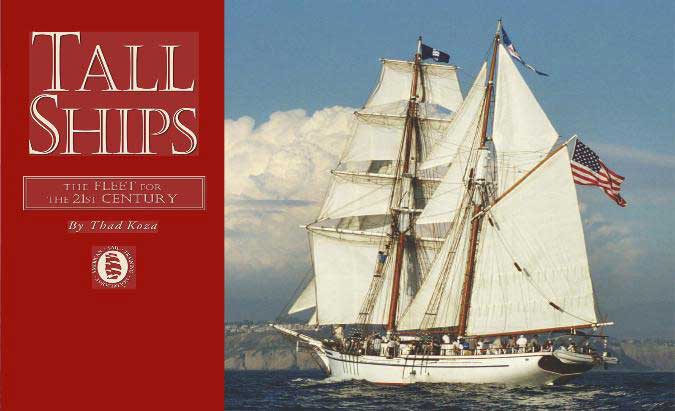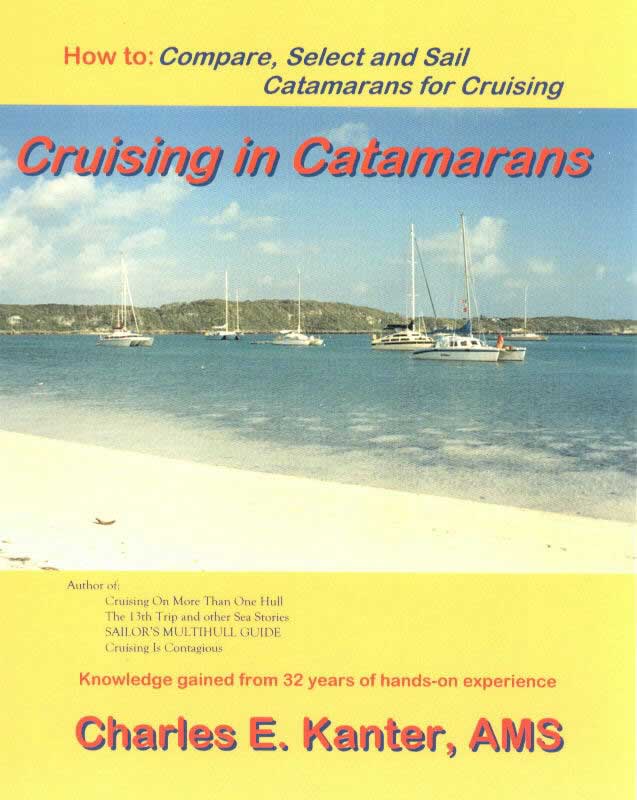The Bookshelf
To The Third Power
by Paul C. Larsen
 |
No one gave them much of a chance. Las Vegas odds-makers listed them as a
100 to 1 shot. Ninety-five percent of the international journalists covering
the America’s Cup picked some other contender and ridiculed the America
team.
But when the yacht America crossed the finish line to win the 1992 America’s
Cup, one of the most improbable victories in the history of the sport was
achieved.
Here’s the inside story of sailing’s most comprehensive test of resources,
technology, tactics, and ingenuity. Never before has an America’s Cup
syndicate put such an emphasis on the use of science to design and build a
racing yacht. Never before has the same scientific method been used to
select and train a crew. Never before has such a de-emphasis been placed on
the so-called “rock stars” of the sport.
To The Third Power is published by West Palm Beach and is available for
$6.50.
Tall Ships, The Fleet For the
21st Century
By Thad Koza
 |
Author Thad Koza has photographed tall ships for more than two decades. He
writes from his experiences on many tall ship voyages and coverage of major
tall ship events. His photographs have appeared in such publications as The
New York Times, The Boston Globe, and Windjammer. 217 pages. 210 plus
full-color photographs. Soft cover, sewn binding, 12 by 9 inches.
Tall Ships is published by Tide-mark Press Ltd. and is available at
www.tidemarkpress.com for $39.95
Cruising in Catamarans
by Charles E. Kanter
 |
Informative, provocative, introspective and critical diagnostic insight from
a yacht surveyor who has crawled through the bilges, climbed over the decks,
sounded the hulls, field tested the installations and sailed the majority of
production cruising catamarans. Charles has raced the speed demons,
delivered the charterboats, consulted on the purchase of countless cruisers,
both multihull and monohull, lived aboard his own 32 foot catamaran for
fifteen years and surveyed hundreds of boats of every condition and
description.
Cruising in Catamarans digests over three decades and 100,000 sailing miles
of experience packed into 406 pages. Learn about cruising catamaran virtues
and vices. Read more historical information and actual facts and figures
about production cruising catamarans and the industry that produces them.
Peruse little publicized characteristics that inhibit the potential
performance of these boats. Cruising in Catamarans provides a blueprint for
realistic expectations and contains charts, diagrams and a unique
methodology for assessing various boats.
Learn the techniques of cruising catamaran sailing and handling. Learn when
to reef, how to judge leeway; how to anchor light displacement boats
including the techniques of bridling, how to take powerboat wakes, how to
handle twin-screw cats. Learn about what characteristics are best for safe
pleasant voyaging and which ones to shun like the plague.
Cruising in Catamarans is published by Cataloging-In-Publication Data and is
available for $29.95.
40,000 Miles
in a Canoe
By John C. Voss
 |
The incredible story of Captain John C. Voss, who, in 1904, completed a
three-year journey across three oceans in a Native American dugout canoe
converted to sail.
40,000 Miles in a Canoe is published by International Marine Publishing and
is available for $12.95.
Lost World
By Tom Koppel
 |
In a captivating blend of extreme science and historical sleuthing, veteran
journalist Tom Koppel tells the inside story of the quest to discover who
first settled in the New World — and how and when they did it.
For decades the issue seemed moot. The first settlers, we were told, were
big-game hunters who arrived from Asia at the end of the Ice Age some 10,000
years ago, crossing a land bridge in the Bering Strait and migrating south
through an ice-free passage between two great glaciers blanketing the
continent. But after years of sifting through data from diverse and
surprising sources, the maverick scientists whose stories Lost World follows
have found evidence to overthrow the "big-game hunter" scenario and reach a
startling and controversial conclusion: The first people to arrive in North
America did not come overland; the came along the coast by water.
Now, for the first time, an award-winning journalist details these
provocative discoveries as he accompanies the archaeologists, geologists,
biologists and paleontologists on their intensive search. Writing with crisp
and often suspenseful prose, author Tom Koppel takes readers along with the
scientists under the sea, into caves, and out to the remote offshore islands
of Alaska, British Columbia and California. Presenting detailed and growing
evidence for ancient coastal migration, he shows how new methods of dating,
underwater imaging and biochemical analysis support conclusions based on
more traditional scientific inquiry.
Lost World is driven by an eloquent and powerful narrative that brings to
life the rich existence of daring maritime pioneers, a sea-faring people who
survived in food-laden refuges on the fringes of retreating coastal
glaciers. By accompanying the key scientists on their intensive search and
recounting with vivid immediacy the risks and failures along with the
satisfactions and breakthroughs, Koppel brings to life the quest for that
Holy Grail of New World prehistory, the first peopling of the Americas. A
fascinating book full of larger-than-life personalities, timeless mysteries,
and astonishing discoveries, Lost World is science writing at its best.
Lost World is published by Atria Books and is available for $26.00.
All contents are copyright (c) 2007 by
Northern Breezes, Inc. All information contained within is deemed reliable
but carries no guarantees. Reproduction of any part or whole of this
publication in any form by mechanical or electronic means, including
information retrieval is prohibited except by consent of the publisher.